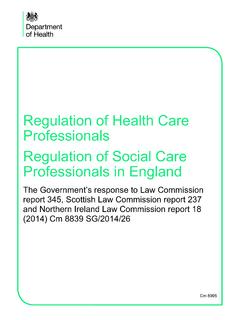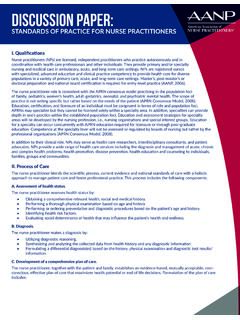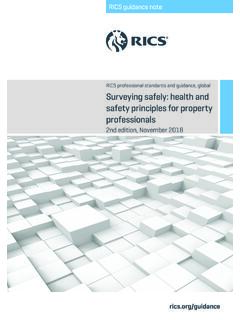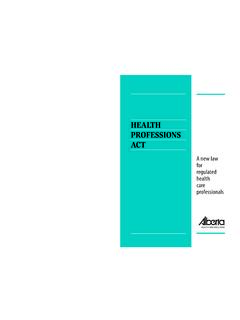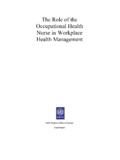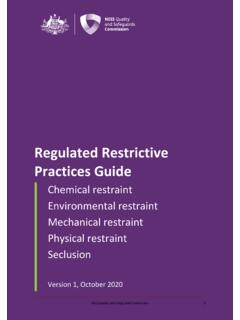Transcription of The role of allied health professionals in public health
1 The role of allied health professionals in public health examples of interventions delivered by allied health professionals that improve the publics health Mapping the Evidence of Impact of allied Helath professionals on public health About public health England public health England exists to protect and improve the nation's health and wellbeing, and reduce health inequalities. It does this through world-class science, knowledge and intelligence, advocacy, partnerships and the delivery of specialist public health services. PHE is an operationally autonomous executive agency of the Department of health . public health England Wellington House 133-155 Waterloo Road London SE1 8UG Tel: 020 7654 8000 Twitter: @PHE_uk Facebook: Prepared by: Linda Hindle, Lead allied health professional , PHE; Dr Sally Fowler Davis, Clinical Academic - Centre for health and Social Care Research Sheffield Hallam University and Professor Pamela Enderby, Professor of Community Rehabilitation, University of Sheffield For queries relating to this document, please contact: Crown copyright 2015 You may re-use this information (excluding logos) free of charge in any format or medium, under the terms of the Open Government Licence To view this licence, visit OGL or email Where we have identified any third party copyright information you will need to obtain permission from the copyright holders concerned.
2 Created November 2015 PHE publications gateway number: 2015521 This document can be made available in other formats on request. Please email 2 Mapping the Evidence of Impact of allied health professionals on public health Contents About public health England 2 Introduction 4 About the allied health professionals 5 Methods 6 Results 10 Research gaps 15 Limitations 16 Conclusion 17 Appendices 17 References 19 3 Mapping the Evidence of Impact of allied Helath professionals on public health Introduction Background The NHS England Five-Year Forward View1 and public health England s (PHE) Evidence into Action2 highlight the national imperative to focus on a preventative approach to improve population health and wellbeing and to ensure health and social care costs remain affordable. PHE and others have recognised the need to engage a wider public health workforce to achieve these desired improvements in health and wellbeing and reductions in health inequalities3.
3 The allied health professions are a group with the enthusiasm, expertise and opportunity to contribute to improving the health and wellbeing of the public4. In April 2014, the professional bodies of the twelve allied health professions (AHPs) in the UK agreed a collective ambition to be recognised as an integral part of the public health workforce. These professions agreed to increase their focus on preventative health care and as a result they have worked with PHE to develop a programme with the following aims: increasing enthusiasm for public health among AHPs increasing the profile of the contribution of AHPs to public health developing the AHP workforce for their public health responsibilities developing the evidence of impact of AHPs on public health work collectively to focus effort across the professions in 4 priority areas chosen because of their relevance to all 12 professions. These priority areas include giving children the best start in life, making every contact count, emotional health and wellbeing and health and wellbeing of older adults AHPs in practice and academia have demonstrated a marked increase in focus on population health and health inequalities.
4 Many AHP interventions whilst not traditionally recognised as public health are contributing to prevention and health improvement. It is clear that knowledge about population impact is required to support changes in practice and therefore PHE commissioned this study to assist AHPs to identify the current evidence base for interventions in public health . PHE commissioned a team of academics led by Sheffield Hallam University to undertake an initial review to: identify examples where there is good evidence of impact on public health by AHPs and therefore an opportunity to broaden practice identify areas which require more focus to demonstrate impact by AHPs on public health 4 Mapping the Evidence of Impact of allied health professionals on public health This report describes the key findings of this work. An academic publication of this work is in press with the Journal of public Health5. About the allied health professionals The AHPs include 12 professions regulated by the health and Care Professions Council (HCPC) who collectively make up the third largest workforce in the NHS.
5 They work across a range of sectors including health , social care, education, academia, voluntary and private sectors; covering the whole life course. The 12 professions include physiotherapists, occupational therapists, podiatrists, dietitians, speech and language therapists, paramedics, radiographers, orthoptists, prosthetists and orthotists, art therapists, music therapists and dramatherapists. allied health professionals (AHP) deliver services to individuals, groups and in some cases specific populations of children and older adults. They work across sectors providing integrated care in health , social care, education, voluntary sector and private settings. What public health means for allied health professionals public health is the science and art of promoting and protecting health and well-being, preventing ill- health and prolonging life through the organised efforts of society6. AHPs contribute to this through their work on physical, mental and social health with individuals, communities and populations across the 4 domains of public health (Figure 1).
6 AHP s actions contribute to primary, secondary and tertiary prevention and address health inequalities. 5 Mapping the Evidence of Impact of allied health professionals on public health Figure 1 AHP contributions across the 4 domains of public health AHPs contribute to virtually every public health priority as part of their routine work although these professionals have not traditionally described their role as public health . Terms such as primary, secondary and tertiary prevention or health promotion are more familiar. For the purpose of this review we defined the scope of public health work to mean any uni- professional or team activity where AHPs offer a specific professional contribution or service, where the service is designed to achieve positive health outcomes for the population. Of particular interest is the domain of health improvement. Methods The study used several methods to identify evidence of interventions by AHPs that contribute to public health : 1.
7 A rapid review of the literature; 2. a survey of AHP practitioners. 3. a consensus method to select evidence-based AHP interventions The data collection included both published evidence (empirical and observational) and reported service information related to AHP public health practices. All data yielded was screened for relevancy against pre-agree inclusion criteria (see Appendix 1). Then an expert 6 Mapping the Evidence of Impact of allied health professionals on public health advisory group including represention from AHP professional bodies completed a consensus exercise to identify criteria for impact and effectiveness for interventions and selected the AHP examples for inclusion in the final report. Nine examples of AHP interventions were selected because they had sufficient academic and practice based evidence and were deemed to offer opportunity for impact and effectiveness at scale. Rapid review A rapid review of the literature was selected to provide a snapshot assessment of published evidence of public health practice by AHPs.
8 The literature review strategy sought to identify interventions undertaken by AHPs across the four AHP priority areas: giving children the best start in life, making every contact count, emotional health and wellbeing and health and wellbeing of older adults. The search used terms to describe AHPs, combined with public health terms used to identify interventions prioritised by AHPs in England: in early years, older people services, for emotional wellbeing and making every contact count , where the AHP practitioner led or had a critical role in the service or the reported research. All search terms were looked for in the title and abstract fields and controlled vocabulary terms were used where available. The Boolean operators 'AND' and 'OR' were used, alongside truncation, phrase searches and proximity operators. The following databases were searched: allied and Complimentary Medicine (Ovid), CINAHL (EBSCO), The Cochrane Library (Wiley), Emerald (Emerald Group), MEDLINE (EBSCO).
9 Only papers situated within a UK context, published between 2004 and 2015 and in the English language were included in the study. The rapid review was confined to publications since 2009 and identified 864 papers of potential interest and the grey literature search yielded an additional 414 resources. After screening for relevancy, data was extracted from 161 papers. Results from the literature searches are presented in Table 1. A table format has been used because 13 separate search strategies were used; one for each profession and a general one for AHPs as a group. 7 Mapping the Evidence of Impact of allied health professionals on public health Table 1 Results of the literature searches following screening for relevance Profession Screening All results - no duplicates for each profession Post title screening Post abstract screening Post full text screening (data extracted) allied health professionals 89 19 all 0 Art therapists 3 2 2 1 Dieticians 187 109 76 33 Dramatherapists 1 0 N/A N/A Music therapists 7 6 4 3 Occupational therapists 131 111 71 26 Orthoptists 6 5 4 4 Paramedics 60 17 8 5 Physiotherapists 181 79* 56 Podiatrists 29 23 18 8 Prosthetists/Orthotists 6 6 5 1 Radiographers 45 22 10 8 Speech and language therapists 119 24 19 16 N/A = not applicable * title and abstract were screened together The papers yielded from the literature searches were screened by the research team for inclusion in this rapid review.
10 In the first instance, papers were assessed for relevance using the title and abstract. The full text of the remaining, potentially relevant, papers was then screened. All papers deemed relevant were then subjected to a structured data extraction process. The project team appraised a selection of the physiotherapy literature to pilot which data needed to be extracted from each paper. A copy of the data extraction template is included in appendix 2 The data extraction was undertaken by three AHP members of the core team with support from a number of AHP managers, to ensure that professional knowledge was used to inform the extraction. Three stages were used, identifying core literature by title, abstract and then full text where they were deemed to be examples of AHP public health interventions. Exclusions were based on: evidence was not relevant to a core area, older people, early years, emotional wellbeing or MECC where the data / protocol or method was not deemed relevant to AHP practice.











